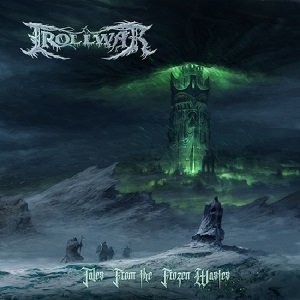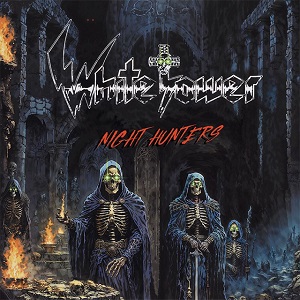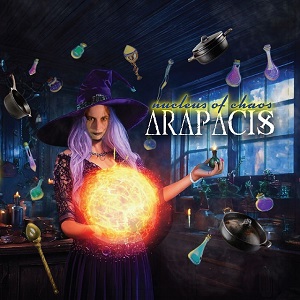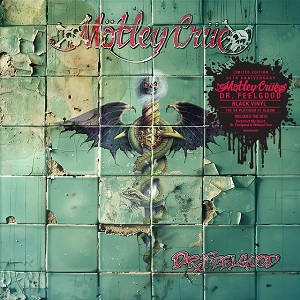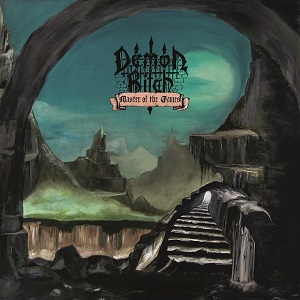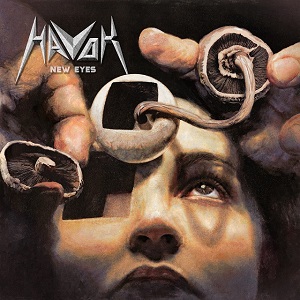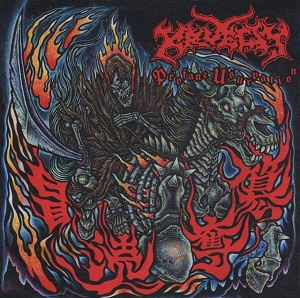CARCASS - The Blood Never Dries
September 23, 2013, 11 years ago
With the exception of BLACK SABBATH’s 13, the new CARCASS album, Surgical Steel, is the most highly anticipated metal release this year. “Maybe in Canada?” chuckles vocalist and bassist Jeff Walker. “I don’t think anywhere else. I’m sure there’s a lot of people that have already written it off.”
Self-deprecating humour aside, it’s been 17 years since the last Carcass studio album, Swansong, was released in 1996. Much more than just another heavy band, UK legends Carcass were beyond the top of their game. They created the masterpieces known as Symphonies Of Sickness and Heartwork. Defining both grindcore and melodic death metal, Carcass were revered the world over… and now they’re back! When asked if the current excitement surrounding Carcass surprises him, Jeff replied, “Well, not really because obviously it’s been a gradual process since we started to talk about a reunion in 2007. It’s not like we’ve come completely out of the blue. We did three years of reunion shows, and it got quite a phenomenal response. We did record this in secret, but it’s not a complete shock to the system like I wanted it to be. Since the information was made available in February, people have known this was on the horizon. Honestly, I think it would have more impact if we’d just announced it when the damn thing was finished. I wanted to have it mastered, artwork done, record deal in place and bam – people find out two weeks before it’s out. Because there’s too much anticipation, people twiddling their thumbs and pontificating about how they think it’s going to sound. I’d rather it just came out and people were like, fuck! Where the hell’s this come from?”

Initially, when Carcass was doing their reunion tour in 2008 and 2009, guitarist Bill Steer was saying we’re probably not going to do a new album, yet the fans were clamouring for one; what convinced the founding fathers to write and record a fresh batch of songs? “I don’t know?” admits Walker. “I’ve been saying since 2008 that I’d be up for doing something; I just needed Bill to come around to the idea of wanting to do it. What’s changed? Bill would say that after the reunion, when he was at home and played the guitar, he was playing Carcass riffs. I think what’s happened is, after Mike (Amott, guitarist) decided that was it, he didn’t have any more time; Bill took stock of the situation. I think the reunion reawakened a passion that was still in him for playing heavy shit; it just rekindled the interest he had when he was younger. I’ve always joked about when he went away and did the FIREBIRD thing. If you follow Firebird’s career, that was starting to get heavier and heavier towards the end. In some respects, he’s gone full circle.”
Because Michael Amott left Carcass after the reunion tour to focus on ARCH ENEMY, drummer Daniel Erlandsson (who also plays in AE) followed suit. As such, drummer Dan Wilding (ABORTED, TRIGGER THE BLOODSHED, HEAVEN SHALL BURN) was recruited. “We toured together in 2008 when he was playing in Aborted, and he came to the attention of Carcass; he was quite impressive, and he’s English. When we started writing stuff, we remembered him from five years ago. He’s quite seasoned; he’s played big shows already. Even though he’s young (24 years old), he’s toured The States three times. It’s not like the Ripper Owens story or that movie (Rock Star) based on it, whisking him out of obscurity. Did he shit himself? No. But I’m pretty sure he was psyched about doing it.” For live purposes, guitarist Ben Ash (PIG IRON, DESOLATION) joins the band, although he did not play on Surgical Steel. “Correct. We approached him earlier this year when we knew we’d have to play live, so we roped him in.”
Speaking of playing live, Carcass only has one Canadian show this year, in Calgary on September 21st at Noctis Festival. That’s followed by a mere five shows Stateside – all of which sold out more than a month in advance. Why not add more gigs? “We’ll do that next year,” says Jeff. “It’s just a case of keeping (their record label) Nuclear Blast happy by doing a few shows in The US on the week of release; we intend to do a proper tour next year. The fact of the matter is, we could easily play to 1000 people at House Of Blues in Los Angeles, but if we come back in six months and do exactly the same thing, it would be a bit boring. In all honesty, we’re trying to create a bit of a buzz. We’re doing a couple of shows at The Troubadour, a tiny place in Brooklyn (Saint Vitus) and a small gig in Manhattan, we’re playing Chicago. It’s more about trying to keep this fun, rather than come through – bam – with a big tour. I don’t want to disclose too much about what we’re doing next year, but it’s going to be a high profile set of gigs. We’re just trying to shake things up and keep it interesting. The thing is… these gigs are probably going to break even; they’re not paying shows, given the financial hardship we’re going to incur. The ticket price is not too extortionary ($20 each). It’s cool to do something cool once in a while.”

Carcass financed Surgical Steel themselves, and after it was recorded, went looking for record companies. “Correct. Again, in an ideal world, the album would have been mixed and mastered, artwork ready to go, and we could have started a bidding war. But the mix, and the whole recording process, was taking longer than anticipated. Last time I was in Los Angeles, I had a CD-R that I was playing for labels. But by then, I‘d already played it for Markus Staiger at Nuclear Blast. The idea was, to just basically shock people and come out with a finished album, rather than this cat out of the bag and people have known for months now. It’s took away from the impact; nothing’s secret anymore. We’re not really interested in showing warts ‘n all, what’s going on behind the scenes. There’s no mystique in music. People are so desperate to try and promote their stuff nowadays with YouTube or Facebook; of course we do that, but there’s no photos of us in the studio, there’s no video footage. There’s too much information out there.”
Colin Richardson was selected to produce Surgical Steel, an obvious choice as he’s helmed everything in the Carcass catalogue - with the exception of their debut album, Reek Of Putrefaction. Was it just like old times? “Yeah, obviously there’s a 17-year credibility gap we have to plug. Getting Colin involved was kind of reassuring for the fans as he’s been involved in the recording of four of our five albums. I think it’s the logical thing to do.” After completing production, Colin tried to mix Surgical Steel but was unsuccessful, and apparently walked out. “He never actually delivered a finished mix to us. I was in Mexico with BRUJERIA, and Andy Sneap told me that he and the engineer were around his studio re-amping the guitar, when he should have been at least a week into the mix. I think he (Colin) was having a hard time with it because he lived with it for so long. He didn’t have a break; he’d been in the studio for nearly four or five months. He got cabin fever. He says he was burnt out on it. I don’t think he was burnt out solely on the Carcass project, I think it’s all the things he got involved with. At the end of the day, he was in to produce it and mix it. He actually doesn’t do much production nowadays; he tends to just mix things. I guess it was more of a gruelling hardship than he originally anticipated. But it was an important decision as producer to ask Andy Sneap (MEGADETH, CRADLE OF FILTH, TESTAMENT) to mix it; he was one of the few people he’d trust to do it. He was looking out for the best.”
Looking back on the writing process for Surgical Steel, Jeff recalls that “It was all done in the rehearsal room really. (Drummer) Dan Wilding had already started on three songs before I even turned up. There was a little bit of technology involved, we’d record rehearsals onto a laptop and then maybe put another guitar down and rearrange things, do some rough vocal guides over it. In that sense it was no different to the old days when we’d record on a four-track or use a tape to tape machine and splice things up. It’s done old school. Nothing was written on a drum machine and presented to anybody; definitely a collaborative effort.”

In addition to the 11 songs that comprise the regular edition of Surgical Steel, the digipack includes an extra cut, ‘Intensive Battery Brooding’, while ‘A Wraith In The Apparatus’ is exclusive to the Japanese version; Jeff discusses these two tracks. “Well, ‘Battery’ is actually one of those songs that starts off in one way, and ends up in a different way. It starts on a really killer, groovy riff; then turns into kind of a thrash song; it’s really cool. And ‘Wraith’, I would liken it almost to ‘No Love Lost’ (from Heartwork). It’s a really catchy, syncopated kind of riff that locks in with the kick drums. There’s a fiddly, technical chorus lick that even back when we were rehearsing with the Arch Enemy guys, Bill was messing around with. It’s a lick he had from the old days. The thing is with these two tracks, and the other tracks that didn’t make the album, they’re not as intense as the way we structured the album itself. The album is extremely aggressive. These songs are still cool and heavy and all that, but for me, they lean almost into Swansong territory. Don’t be alarmed! They’re a hell of a lot better than anything we did for Swansong; it’s a lot more accomplished. ‘Battery’ is also on the back of the 7” (vinyl single for ‘Captive Bolt Pistol’).” The aforementioned “other tracks” that didn’t make the album are quickly expanded upon. “There’s one called ‘Livestock Marketplace’ and one called ‘Zochrot’, which is on the Decibel flexi-disc already. So these songs are leaking out.”
Touching on some of Jeff’s lyrics, we begin with ‘Thrasher’s Abattoir’ in which the verses are comprised of rather gruesome lists, yet the chorus states point blank: Hipsters and posers I abhor. “That song’s kind of a throwback. Lyrically it’s based on something Ken (Owen, drummer) wrote before he left back in ’85. That’s where the song title comes from – the rehearsal tape. And lyrically, thematically, it’s the same thing. It’s only tongue in cheek, but I’ve updated it to include hipsters. God knows the scene’s full of fucking posers as well; people trying to be cool as fuck. It’s not to be taken too literally, you know what I mean.”
‘A Congealed Clot Of Blood’ may appear at first glance to be associated with hemostasis, but that’s highly inaccurate. In it Jeff sings: Nothing is true but infinite human conflict. Do true prophets come armed with sword? “Yeah, I won’t be vising Pakistan, I know that much. Is it bold? I don’t think it is because I’ve chosen my language very carefully. That song’s about fundamentalism.” Religious intolerance is gaining increased media coverage world-wide, was that influential in the writing of this song? “Of course, there’s been a war in fucking Iraq and Afghanistan for the past ten years or however fucking long; you can’t ignore that kind of stuff.”
Many listeners are curious as to the significance of the numbers counted off in ‘The Granulating Dark Satanic Mills’, those being: Six, Zero, Two, Six, Nine, Six, One. But don’t expect Jeff to come clean that easily. “Maybe I should have a competition? Some people have given me some really cool ideas of what they think it is. I’d rather leave that to the imagination. Ultimately, people can extract what they want from the words. There’s no agenda or deep philosophy, I’m not trying to instill any ideas in anybody.” Towards the end of that song, a rather ironic line is uttered: A working class hero is something to be. “It’s a quote from JOHN LENNON isn’t it… always got to have a BEATLES quote in a Carcass album, living in Liverpool.”
‘Captive Bolt Pistol’ was the first song released from Surgical Steel. In it, Dr. Hugo Heiss is name-checked as he invented the instrument in 1903. But Dr. Temple Grandin also gets called out. “Because she’s the architect of the modern abattoir; she’s a contradiction in terms. She’s meant to be for animal welfare, but she’s actually constructed… if you ever drive from Los Angeles to San Francisco, there’s a massive complex there that we always refer to as Cowschwitz. There’s probably half a million cows and an abattoir there. She’s basically sanitized and industrialized the method of killing animals without distressing them too much. But isn’t that a contradiction? You’re killing something! So you’re trying to be as nice as possible before you kill something. It’s such a contradiction. That’s why she gets a good mention. She’s written books about animal welfare, but she’s also basically designed a method of killing them.”

The Surgical Steel artwork is undoubtedly traditional Carcass. The tools depicted are capable of causing tremendous pain, yet the image actually invokes a comfortable feeling of familiarity. “I hope so,” affirms Jeff. “The circle tool design is almost like a corporate symbol isn’t it. We wanted something familiar yet new. The same way that QUEENSRŸCHE have used their symbol on their new album; it gives a reassurance that this is something new, it’s been updated, but it’s something familiar. It’s a very cynical piece. It’s definitely trying to evoke the furor of Necroticism and Heartwork. I think it’s showing our roots, and it goes with the music and lyrics as well. There’s a lot of things we can link to our past – the obvious with the track ‘1985’. Or be it some of the riffs, it’s a real mixed bag. I don’t want to give people the impression we’re scraping the bottom of the barrel, or trying to stick together ideas that were on the cutting room floor from the old days, ‘cause we aren’t. A lot of it is material that Bill never presented to me, or the band.”
If people are looking for a bone to pick, they might say the Surgical Steel artwork is too similar to the Tools Of The Trade EP. “Well it’s not. The Tools Of The Trade EP is a photograph with some copyright-free graphics layed over top of it. This is a real photograph of real images; the only similarity is the circle of tools. If people want to be fucking clever, then why aren’t they saying it looks like the CD or the vinyl label of Necroticism? ‘Cause that’s what it originates from.”
Returning to the introductory number ‘1985’, in part one of Nuclear Blast’s track by track with Bill and Dan, they mention ‘1985’, saying it’s from an old rehearsal tape that Bill had long since lost. The story goes that Jeff found it online and insisted this would start the album. “That’s not entirely true. I came across it by chance. We didn’t go into the studio with any intention of recording that. It’s literally a case of Bill was tracking rhythm guitars and I was sat in the corner. I found torrents of our old rehearsal tape and said we’ve got to redo this; this is killer! Bill was very resistant to my idea. That evening we went to see a band doing covers, and one of the covers they did was ‘Electric Eye / The Hellion’, the intro (for JUDAS PRIEST’s Screaming For Vengeance). I was telling Bill how we could update this music, and he thought it was cool; there was never any intention to start the album with it. We don’t think of that kind of bullshit, a clichéd intro for an album. But it turned out so cool and so perfect… it’s just one of those things that happened. It wasn’t deliberate.”
As is the norm now, the album is being released in multiple formats: CD, Digipack, Digital, even vinyl is common once again – in smaller amounts aimed at collectors. But the fact that Surgical Steel is being released on cassette came as a big surprise. “My initial reaction was, who the hell is ever going to play a cassette? But I think it’s just one of those things that people collect. Hell, people collect t-shirts and patches; and these things go for silly money. People have got to have hobbies you know. It’s obviously an outdated format, it’s really weird but there is a market for it; people are genuinely excited. It was Nuclear Blast’s idea; they’re pretty in touch with what people want.”
If nothing else, Surgical Steel makes people think. 'Noncompliance To ASTM F 899-12 Standard' is a curious song title that’s quite likely to cause a Google search, resulting in the knowledge that it’s the specification covering the chemical requirements for wrought stainless steels used for the manufacture of surgical instruments. “There you go, we’re filling a gap in the Canadian educational system, aren’t we?”
To learn more, visit the official Carcass Facebook page.


